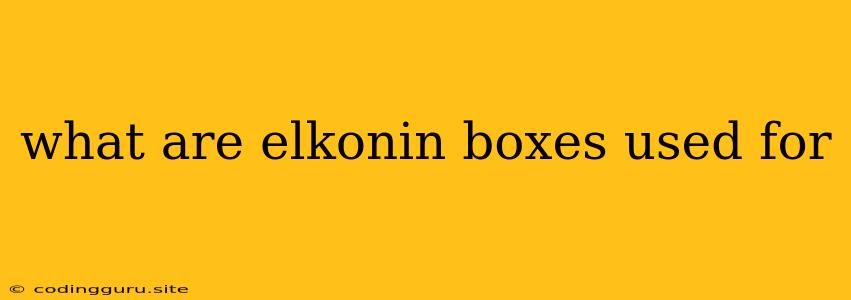What Are Elkonin Boxes Used For?
Elkonin boxes are a visual tool used to help students learn to sound out words and decode them into individual phonemes (sounds). They are particularly helpful for young learners who are struggling with phonemic awareness, the ability to hear and manipulate individual sounds in words.
How Do Elkonin Boxes Work?
Elkonin boxes are simply a series of squares or boxes drawn on a piece of paper or whiteboard. Each box represents a sound in a word.
Here's how they are used:
- Choose a word: Start with a simple word that the student is familiar with, such as "cat" or "dog."
- Draw the boxes: Draw a box for each sound in the word. So, for "cat," you would draw three boxes.
- Say the word: Say the word slowly, emphasizing each sound.
- Point to the boxes: As you say each sound, point to the corresponding box.
- Write the letter: Have the student write the letter that represents each sound in the box.
Benefits of Using Elkonin Boxes
- Visual representation: Elkonin boxes provide a visual representation of the sounds in a word, making it easier for students to see and understand the connection between letters and sounds.
- Improved phonemic awareness: The process of breaking down words into individual sounds helps students develop their phonemic awareness skills.
- Enhanced decoding skills: By using Elkonin boxes, students learn to identify the sounds in words, which helps them decode new words.
- Fun and engaging: Elkonin boxes can be a fun and engaging way to learn about phonics, making it more enjoyable for students.
Examples of Using Elkonin Boxes
Here are some examples of how you can use Elkonin boxes:
1. Blending Sounds:
- Teacher: "Let's sound out the word 'cat.'"
- Teacher: (Points to the first box) "What's the first sound in 'cat'?"
- Student: "C"
- Teacher: (Points to the second box) "What's the next sound?"
- Student: "A"
- Teacher: (Points to the third box) "And the last sound?"
- Student: "T"
- Teacher: "Now, let's put those sounds together. What's the word?"
- Student: "Cat"
2. Segmenting Sounds:
- Teacher: "Let's break the word 'dog' into its sounds."
- Teacher: (Points to the first box) "What's the first sound in 'dog'?"
- Student: "D"
- Teacher: (Points to the second box) "What's the next sound?"
- Student: "O"
- Teacher: (Points to the third box) "And the last sound?"
- Student: "G"
3. Writing Words:
- Teacher: "Let's write the word 'hat.'"
- Teacher: (Points to the first box) "What's the first sound in 'hat'?"
- Student: "H"
- Teacher: (Points to the second box) "What's the next sound?"
- Student: "A"
- Teacher: (Points to the third box) "And the last sound?"
- Student: "T"
- Teacher: "Now, write the letters in the boxes."
Tips for Using Elkonin Boxes
- Start with simple words: Begin with short, easy-to-sound-out words.
- Use a variety of words: Include words with different consonant blends, digraphs, and vowel sounds.
- Make it fun: Use different colors, markers, or stickers to make the boxes more engaging.
- Practice regularly: Use Elkonin boxes for short, frequent practice sessions.
Conclusion
Elkonin boxes are a valuable tool for helping students learn to read and spell. By providing a visual representation of sounds in words, they can help children develop essential phonemic awareness skills and improve their decoding abilities. With regular practice, Elkonin boxes can be an effective tool for enhancing literacy development.
